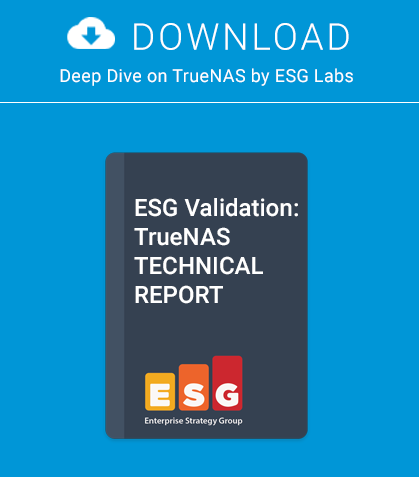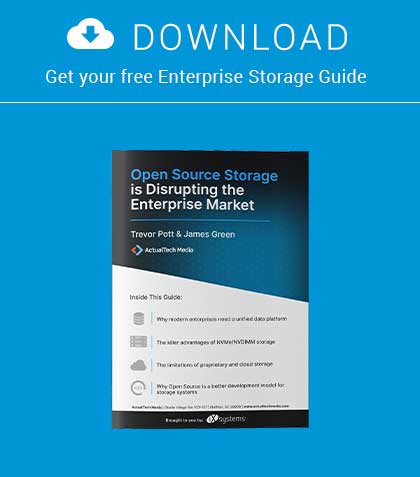NOTE: This is historical content that may contain outdated information.
TrueNAS Z35 Unified Storage Array Receives Top Ranking in DCIG’s 2016-2017 iSCSI SAN Utility Storage Array Buyer’s Guide
SAN JOSE, CA–(Marketwired – March 16, 2016) – iXsystems, the industry pioneer in enterprise storage and servers driven by Open Source, today announced that the TrueNAS Z35 received the top ranking from DCIG in their 2016-2017 iSCSI SAN Utility Storage Array Buyer’s Guide. Representing iXsystems’ fourth DCIG Buyer’s Guide win, the iSCSI SAN Utility Storage Array Buyer’s Guide evaluated more than 100 different criteria across 67 different storage arrays from 14 different storage vendors, including Dell, HP, EMC, and NetApp.
Each storage array was rated “Recommended,” “Excellent,” “Good,” and “Basic.” DCIG evaluated the TrueNAS Z20, Z30 and Z35. The TrueNAS Z35 received the highest rating of “Recommended.” iXsystems was one of only three vendors to get the “Recommended” rating. DCIG also rated the TrueNAS Z30 “Excellent” and the TrueNAS Z20 “Good.” The guide can be requested from the iXsystems web site here.
“The DCIG iSCSI SAN Utility Storage Buyer’s Guide shows that TrueNAS has the features required to provide highly available and reliable utility storage that scales into the petabytes at a very low cost per TB,” said Ken Clipperton, Lead Analyst, Buyer’s Guides at DCIG LLC. “TrueNAS enables organizations to confidently and cost-effectively keep large amounts of data online and accessible for their business needs.”
Unlike other DCIG Buyer’s Guides, price was evaluated as both an inclusion and evaluation criteria. Arrays included were required to be under one dollar per gigabyte, to scale to at least 75 GBs of raw capacity, to offer all-HDD configurations, to support the iSCSI protocol, and to be available before September 1, 2015.
TrueNAS is a tightly-integrated hardware and software storage array based on enterprise-grade Open Source technology. Its flexibility as a unified block and file storage array starts with OpenZFS, which enables unlimited snapshotting, cloning, and rollback that allows you to effortlessly deploy new virtual machines or quickly restore your productivity after a ransomware attack. TrueNAS is also certified for all popular hypervisors including VMware, XenServer, and Hyper-V. It also supports native protocols and interfaces like VMware VAAI, VMware vCenter as well as Microsoft ODX, VSS, and Veeam Backup.
The TrueNAS Z20, Z30 and Z35 are hybrid arrays that combine RAM and Flash with HDDs, using a technology called TrueCache™ to optimize performance with the capacity of HDDs. TrueNAS provides unified storage functionality through the concurrent support of one or more block and file protocols. It is based on OpenZFS so its file system can take precautions to prevent bit rot or data corruption caused by power outages, system panics, faulty caches or other causes, making it superior to many of the competitive products in this guide.
The guide mentions that the TrueNAS Z35 supports 4PB, however the TrueNAS Adaptive Compression (TAC) stretches effective capacity beyond 10PB in some cases, making it the most affordable of any enterprise-class storage array in the DCIG guide. TAC is in-line, eliminates the redundancies in stored data, compresses what it can, and skips over already compressed data. It reduces the size of I/Os before they reach storage media, which also increases I/O performance.
“iXsystems is proud to have TrueNAS at the top of another DCIG Buyer’s Guide. This particular recognition is especially meaningful because it validates the iXsystems strategy of combining our Open Source software with a custom-designed, purpose-built hardware platform to deliver exceptional enterprise storage that’s disrupting the market with its unrivaled low TCO,” said Brett Davis, Executive Vice-President of iXsystems. “Having TrueNAS at the top of the list of a guide where cost is a consideration reaffirms what our customers have already discovered — that TrueNAS is the best value in enterprise storage.”
DCIG stated that the TrueNAS Z35 stands out as the best value in an iSCSI SAN utility storage array. DCIG shows that TrueNAS has the enterprise features, availability, and reliability of other competitors such as Dell, EMC, HDS, HP, and NetApp but often at less than half their price. DCIG also reported that none of them could store more data in a single rack than TrueNAS.
The iXsystems TrueNAS Z35 achieved the top score of “Recommended,” due in part to the following:
- Superior hardware horsepower, network bandwidth, and storage I/O compared to other arrays
- RAW capacity that scales to nearly 4PB
- The second highest storage density of 110TB/RU
- A cost of less than $150/TB
- Self-healing data architecture with in-line compression and deduplication
- Non-disruptive upgrades and extensive support options
- Support of VMware VAAI
- Concurrent support of block and file protocols
- Supports all five of the flash-based caching options evaluated by DCIG
- Remote management via VMware vCenter, and web-based management interfaces
In 2015 TrueNAS arrays earned an “Excellent” ranking from DCIG in both hybrid and all-flash configurations. The following DCIG guides include TrueNAS:
- A top ten finish with an “Excellent” rating in the “SME Hybrid Storage Buyer’s Guide”
- A top ten finish with an “Excellent” rating in the “Midsize Enterprise Hybrid Storage Buyer’s Guide”
- A top ten finish with an “Excellent” rating in the “Sub-100TB All-flash Array Buyer’s Guide”
- A top ten finish with an “Excellent” rating in the “Sub-250TB All-flash Array Buyer’s Guide”
- An “Excellent” hardware rating and an “Excellent” support rating in the “All-Flash Array Buyer’s Guide” (for the TrueNAS Z50)
All these guides prove that TrueNAS lowers the TCO of your storage deployment. To learn more about TrueNAS send an email to sales@iXsystems.com, call 1-855-GREP-4IX, or visit www.iXsystems.com/TrueNAS.

